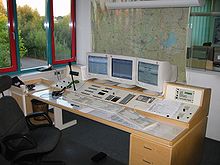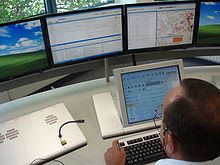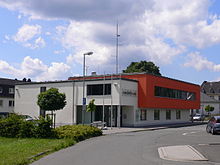Operations control center
An operations control center (seldom also called operations center or simply control center ) manages the operations of the assigned organizations, receives information, evaluates it and coordinates the connected services.
In particular in the context of public services there are control centers that
- for fire fighting ,
- for the preservation or rescue of important property,
- for civil protection ,
- in the medical and technical rescue service , to save human life,
- in matters of public safety and order
Answer emergency calls and use the rescue service , fire brigade , technical relief organization , police and other emergency services. As a rule, they can be reached around the clock and are in contact with each other by telephone, radio and sometimes data lines. Throughout Europe, a contact person can be reached on the emergency number 112 who can provide help in the areas mentioned.
tasks
Typical tasks are:
- Acceptance of an incoming emergency call or the alarm message from an alarm system (e.g. fire alarm system )
- Querying and recording with the computer , see also the control system
- Prioritization: Is there a non-urgent operation, an emergency or even a major event of considerable importance?
- Decision : Which means come into question ( alarm and release regulations (AAO), responsible fire or rescue station )? Who still needs to be informed (other control centers, special organizations and people)? The deadline for assistance must be observed, which determines how quickly a rescue device must be at the place of use.
- Alarming via radio ( voice radio , triggering of radio receiver or siren ), in-house loudspeaker system, telephone , alarm fax or other suitable systems (e.g. also SMS or radio data transmission , see fire brigade alarm systems )
- Transmission of mission orders: after the alarm, the units report to the control center and receive mission commands, possibly also directions or special instructions / warnings (e.g. about dangerous substances)
- Support and coordination during the operation: Inquiries for rescue equipment are processed, based on the findings of the emergency services on site, further resources may have to be sent there (e.g. additional requests from an emergency doctor or rescue helicopter ), special aids must be organized (e.g. Special extinguishing agents), hospitals are asked about their capacity to accept certain patients, etc. The area of responsibility also includes inquiries that may be necessary at the poison information centers .
- Ensure that you can continue to operate: If many of your own units are on the move, you must ensure that reserve forces cover the area of operation if further deployments become necessary. A state of emergency may have to be declared.
- Warning of the population: in certain situations control centers are also responsible for passing on information and warning messages to the public, e.g. B. with traffic reports and radio announcements, the remote switching of traffic signs , triggering of siren alarms - there are also attempts and considerations made to warn the population by means of SMS or radio clocks ; Since September 2011, the Siegen-Wittgenstein district control center has also been warning the population via the social network Facebook
- Documentation of the deployment data: in addition to the framework data from the emergency call (location, cause of deployment), all times and special events are recorded - receipt of the emergency call, alerting the units, reporting and departure of the units, arrival at the location, departure from the location, arrival at the hospital or back at the unit's location.
Control center types
Emergency services
There are numerous services that operate a control center as a central contact. The names and abbreviations are from Germany, similar or adapted names are also used in other countries:
| designation | Specialist service | special tasks |
| Fire Brigade Operations Center (FEZ) Main Operations Center (HEZ) Fire Brigade Control Center (FLSt) | Fire brigade , other disaster control units | Receipt of emergency calls via the European emergency number 112, carries out alarms or post-alarms, organizes special equipment (special vehicles, special extinguishing agents) in regular operation, receives emergency calls from automatic fire alarm systems, supervises radio communications, and serves as a flood reporting point in some districts. Some control centers that are manned by professional fire brigades also act as reporting heads for the city administration or the district outside of their office hours. |
| Police operations center for emergency call and immediate management | Police (partly specializing in traffic operations centers ), security authorities , offices | Mediation to the competent authorities |
| Rescue coordination center (RLSt) | Ambulance service , ambulance service , medical service , care service | queries hospitals that are ready to be admitted, assigns the target hospital, gives first aid instructions until the rescue equipment arrives |
| Integrated control center (ILS or ILSt), also called central control center (ZLSt) | Fire and rescue services (e.g. water rescue service ) | takes over the alerting of the fire brigade and rescue service and is basically the rear command post |
| Ambulance control center | Ambulance | Organization of intensive relocations and repatriations abroad |
| Doctor switching center | Medical on-call service | arranges a family doctor on duty outside of office hours |
| Home Emergency Call Center | Home emergency services, care services | passes on emergencies from affiliated members to RLSt, PEZ or FEZ |
| Mountain rescue (headquarters) | Mountain rescue service, partly avalanche warning | organizes and coordinates rescue in mountain accidents, avalanches and other alpine emergencies |
| Security center / emergency call and service control center (NSL) | Security services | monitors facilities, e.g. B. by means of intrusion alarm systems or cameras, but also personal assistance in case of stuck elevators . |
| Emergency Control Center (NFL) | Plant security / aid facility for railway infrastructure companies | Coordinates accident assistance from the point of view of DB AG and supports the technical operations management on site. She is not the chief of operations . Operations management remains with the fire brigade or rescue services. |
| Traffic / transport lines (TP / VL) | Railway companies (EVU) z. E.g .: DB long-distance traffic, metronome, DB regional etc. | Monitor railway operations and intervene in a coordinating manner in the event of disruptions. Use auxiliary locomotives and trains as well as emergency services for passenger care. Decision-makers for their RU for further procedures such as B. evacuation of a train, line closures, rerouting of trains. |
In the field of non-police security, a development towards larger and larger control centers can be seen for reasons of cost (personnel costs, technology costs). In a first step, fire brigade control centers and rescue control centers were merged into so-called "integrated fire and rescue control centers" (ILS) in many places. The next step is - v. a. in Northern and Eastern Germany - the formation of so-called "Integrated Regional Control Centers" (IRLS), which are not only responsible for the fire brigade, rescue service and disaster control in a district or an independent city, but also take on these tasks for several regional authorities. The IRLS West in Elmshorn went into operation as the first IRLS in Germany in 2001, which from then on directed all operations of the non-police BOS in the three districts of Pinneberg, Steinburg and Dithmarschen. This development is completed by the formation of so-called “Cooperative Regional Control Centers” (KRLS), in which the police are accommodated in addition to the non-police hazard prevention. In contrast to some parts of the Anglo-Saxon region, however, there is no mixing of police and non-police tasks in these control centers. Both danger prevention areas use one building and the same highly specialized control center technology, but police officers only answer the emergency number 110 and municipal operations officers only answer the emergency number 112 and process them strictly separately for their respective areas of responsibility. One of the first control centers of this type is the Cooperative Regional Control Center (KRLS) North in Harrislee near Flensburg, which started operations on September 4, 2009. The KRLS West in Elmshorn followed on April 20, 2010.
In Lower Saxony there are five cooperative regional control centers with locations in Oldenburg, Osnabrück, Wittmund, Hameln and Lüneburg. The Hameln control center (“Cooperative Regional Control Center Weserbergland”) went into operation in April 2008, making it the first of its kind in Germany.
However, in some rural areas without a permanently manned fire brigade control center, the fire brigade is alerted via the police operations centers (PEZ).
Control centers of authorities
The authorities have set up control centers that can also be linked internationally. They are activated as contact persons for various organizations, especially in the event of large-scale disasters.
In Austria there are in the Interior Ministry , the Federal Alarm Center and in all federal states each have a state warning center of the provincial governments. In the state warning centers, for example, all automatically recorded measured values from the environmental probes or flood levels converge and trigger the corresponding alarms when the corresponding levels are reached.
Further control centers in the security area:
- Regulatory authorities
- Plant fire brigades for your own plant and, if necessary, also for regional special assistance ( TUIS )
- SAR center for search and rescue missions at sea and air accidents
- Situation centers of the interior ministries
Other organizations
Other organizations with supraregional or public significance and their own task forces also have operational control centers, e.g. B .:
- Transport companies, ice rink infrastructure companies, railway companies
- Electricity works , gas works and water works operate network control centers
- Automobile clubs
Special forms
- Post-alerting center (NASt): in the case of larger operations or a large number of operations (e.g. severe weather disasters), it may make sense to set up additional control centers to carry out the tasks on a subordinate level in order to relieve the responsible control center. This is practiced in the fire brigade in particular, in that a prepared radio room is occupied by a volunteer fire brigade and can perform regional tasks for operational support.
- Integrated control center (ILS or ILSt, also central control center or integrated rescue control center or integrated regional control center IRLS): in an ILS, rescue services, fire brigade and disaster control are jointly dispatched. This significantly reduces personnel and technical expenditure and is intended to reduce unclear situations by allowing information to flow directly (from table to table, so to speak). But it also means that the dispatchers / operations clerks who are deployed require very extensive training in all subject areas. Integrated control centers are the standard in almost all federal states. In the meantime, Bavaria and Saarland have also been converted to integrated control centers across the board. Only in the states of Rhineland-Palatinate and Baden-Württemberg are such control centers not yet available nationwide. In both countries, the nationwide establishment of integrated control centers is required by law. However, the full implementation will take a few years, because in the past the separation of the service number 19222 for the rescue service and the emergency number 112 for the fire brigade was traditionally practiced. The integrated control center for Mainz and the new control center for Heidelberg / Rhine-Neckar are currently missing. In Vorarlberg , Austria, rescue services, fire brigade, water and mountain rescue are coordinated by the RFL (rescue and fire brigade control center). In Tyrol, too, a supra-regional coordination of fire, rescue and alpine operations was achieved with the establishment of the Tyrolean Control Center .
- District operations center : An optional facility in Bavaria to support and relieve the integrated control centers in the event of major damage and in the event of a disaster.
- Instructional control center: For the training of control center dispatchers, instructional control centers are usually maintained at state fire brigade schools. The closer a training center corresponds to reality, the better and more real the training. The environment outside the training center (resources, other authorities and agencies, emergency calls) is only simulated. There are control rooms available for this. Prepared scenarios and scripts must be worked through by the dispatcher during the training.
- Mobile control center (MLS): It is a spacious special-purpose vehicle that combines the core functions of a control center in a very small space and is used at open-air events, major loss events or disasters. During such an operation, all regional communication takes place via this facility, which reports to the head of operations. The advantage is that the MLS operates independently and thus the regular control centers are relieved (see also command vehicle ).
The terms "combined control centers" and "integrated control centers" are often used synonymously , although they have different meanings .
Responsibilities
The individual control centers can have clearly separated or overarching areas of responsibility, both organizationally and locally.
In Germany they usually cover the area of a larger city or one or more rural districts.
In Austria, district alarm and warning centers, area alarm centers or state warning centers at district or state level are also common for fire brigades . In the Austrian rescue service , the organizations involved (e.g. Red Cross , Samaritan Association, etc.) are often coordinated by the organization's own control centers. In Lower Austria , a separate company, 144 Notruf Niederösterreich (formerly LEBIG), was founded in 2003 , which coordinates the various rescue services for the entire state from four different locations and at the same time supports the patients or the helpers by telephone until the first operational resource arrives on site.
operator
The operation of the control centers of the authorities and organizations with security tasks is regulated differently by law or ordinance.
Authorized control centers ( police , professional fire brigade ), operation by the responsible district or city or a special purpose association, or by an aid organization commissioned with the operation come into question.
staff
The employees at control centers are called dispatchers or operations clerks (sometimes also called operations workers for short ). Depending on the legal relationship, they are employees or civil servants of the control center operator. In most control centers at least two dispatchers are on duty, in larger organizational units (large cities and regions) there are as many as 20 at the same time. The staffing is measured according to the expected workload, so that the number of dispatchers can be significantly higher depending on the area of responsibility and the workload. The control center of the Berlin fire brigade , for example, has 45 workstations.
Depending on the internal organization, a dispatcher takes on the processing of a complete order from the emergency call to the end of the mission, or the tasks involved are divided among several dispatchers ( telephone operator , radio operator ).
The dispatchers in the control center usually have the training in their area that is also necessary for the emergency personnel on site, often also management training. They also have special additional training for work in the control center. You must be familiar with the area and have good knowledge of the possible uses of your own and neighboring organizations.
Operations clerk at the central control centers and radio stations in Hessen z. B. must be paramedics or emergency paramedics, as well as group leaders of the fire brigade, before they complete a five-week course for emergency officers at the Hessian state fire brigade school in Kassel.
The team at a control center must constantly keep track of, in some cases, several simultaneous operations and coordinate with each other. Therefore, in addition to specialist knowledge, teamwork , communication skills and stress resistance are required.
Further positions in a control center are:
- Control center manager / operations manager: Supervisor of the employees
- Shift supervisor / situation manager: boss of the current shift
- System administrator: looks after the operations control computer
- Technician: e.g. B. for the radio systems
- Administrative staff.
equipment
Above all, control centers need communication devices:
- Telephone (internal service numbers, emergency lines, alarm lines to the guards ) and fax ,
- Radios on different frequencies for connection with one's own and other forces

Uninterruptible power supplies and emergency power generators ensure smooth operation in exceptional situations.
Other auxiliary materials are alarm plans , maps , sound recorders, video transmission, etc.
The dispatchers are usually supported in their work by a computer- aided control center system ( operations control computer ). This system ensures the archiving of deployment data, makes alarm suggestions, provides road / location maps and deployment plans, ensures that units are automatically alerted at the touch of a button, transfers deployment data, connects the various workplaces or even different control centers with each other and helps with statistical evaluations and Settlements. These systems are often duplicated for security reasons.
The extension of the voice radio by a radio reporting system facilitates the work by relieving the radio traffic and the direct connection to the operations control computer (automatic documentation of departure and arrival times, display of free and occupied vehicles, partly also geodata of the operational resources).
See also
Web links
- LstSim.de - non-commercial control center simulation
Individual evidence
- ↑ District of Siegen-Wittgenstein : District control center now also provides information via Facebook ( Memento from June 4, 2015 in the Internet Archive ). In: siegen-wittgenstein.de, September 14, 2011, accessed on May 1, 2020.
- ↑ Lower Saxony Ministry of the Interior and Sport : Answering the oral inquiry from the FDP on emergency calls. In: niedersachsen.de, June 27, 2014, accessed on May 1, 2020.




